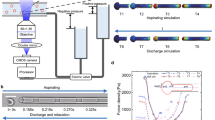Abstract
ABSTRACT: Red blood cell (RBC) deformability in rats of various ages was assessed by filtration (3 μm Nuclepore membranes). Neonatal rat RBC (1 d old) had lower filter-ability, both in terms of RBC incremental volume (9.97 ± 1.85 versus 0.33 ± 0.28 nL at 180 d of age, mean ± SD, p < 0.001) and the number of filter clogging particles (25.7 ± 3.1 versus 18.9 ± 3.4 RBC × 103/s, p < 0.001). The lower filterability correlated with a larger RBC volume (169 ± 12.6 versus 69 ± 3.2 μm3, p < 0.001) and with a wider minimum cylindrical diameter (3.87 ± 0.15 versus 2.84 ± 0.05 μm, p < 0.001). Almost all of the neonatal RBC had a minimum cylindrical diameter exceeding the 3 μm nominal pore size of the filters. The calculated resistance to initial folding was also significantly greater, as indicated by a static bending analysis of initial deformation. However, when the larger size of neonatal RBC was taken into consideration, and thus their greater projected area on which forces are applied, they appear to be at least as deformable as the adult type RBC. This finding may explain the contradiction between RBC filtration experiments and other approaches based on RBC deformations in shear flow, which have been unable to detect a hampered flexibility of neonatal RBC. In view of the more pronounced differences between neonatal and adult RBC in rats than in human subjects, the rat is an interesting model for studying this physiologic phenomenon in newborns.
Similar content being viewed by others
Log in or create a free account to read this content
Gain free access to this article, as well as selected content from this journal and more on nature.com
or
Author information
Authors and Affiliations
Rights and permissions
About this article
Cite this article
Gunnar Engström, K., Ohlsson, L. Morphology and Filterability of Red Blood Cells in Neonatal and Adult Rats. Pediatr Res 27, 220–226 (1990). https://doi.org/10.1203/00006450-199003000-00004
Received:
Accepted:
Issue date:
DOI: https://doi.org/10.1203/00006450-199003000-00004



